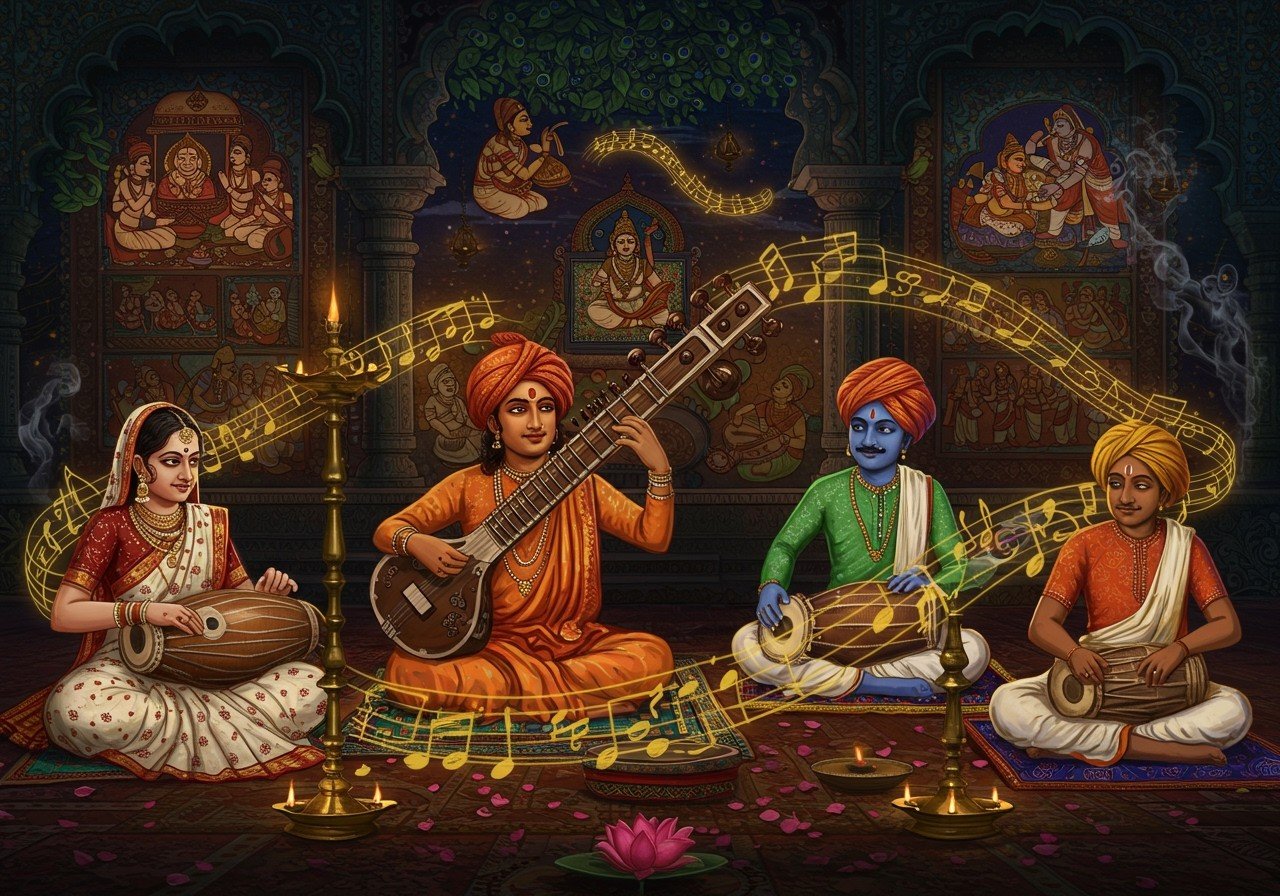
Indian folk music, a vibrant expression of the nation’s cultural heritage, resonates deeply within the hearts of culturally rooted Indians, particularly those from middle to upper-middle-class backgrounds who cherish tradition. This blog delves into the multifaceted world of Indian folk music, tracing its historical roots, regional variations, and enduring significance in contemporary society.
What is Folk Music of India?
Folk music in India, unlike classical music with its strict rules and compositions, thrives on spontaneity and community engagement. Passed down orally through generations, it forms an integral part of festivals, rituals, and daily life, often involving the entire community. This vibrant tradition weaves together tales of mythology, historical events, and the nuances of rural life, preserving linguistic and cultural diversity across India’s varied regions.
Traditional instruments often accompany these narratives, creating a rich auditory experience. Some common instruments include:
- Dholak: A two-headed hand drum, providing rhythmic backbone to many folk styles.
- Ektara: A one-stringed instrument, often used for melodic accompaniment and storytelling.
- Shehnai: A double-reed wind instrument, known for its melodious and often melancholic sound, frequently used in celebrations and processions.
- Flute: A simple yet versatile instrument, capable of expressing a wide range of emotions and melodies, common across many folk traditions.
Regional Variations in Indian Folk Music
India’s diverse landscape nurtures a rich variety of regional folk music traditions, each with its distinctive characteristics. These traditions, shaped by local dialects, instruments, and dance forms, showcase the unique identity of each region. Here are a few examples:
- Rajasthan: Known for vibrant styles like Ghoomar, a swirling dance form, and Kalbelia, the music of the snake charmers.
- Punjab: Home to energetic forms like Bhangra, with its infectious beats, and Giddha, a lively dance performed by women.
- Maharashtra: Showcases Lavani, a dramatic and expressive dance form, and Powada, a narrative ballad tradition.
- Bengal: Known for Baul, a mystical and spiritual tradition, and Bhatiyali, the songs of boatmen.
- Tamil Nadu: Features Kummi, a folk dance performed in circles, and Karagam, a dance performed balancing pots on the head.
- Kerala: Rich in ritualistic forms like Theyyam, a dance form involving elaborate costumes and masks, and Margamkali, a traditional Christian dance.
Historical Evolution of Indian Folk Music
Over centuries, Indian folk music has evolved, shaped by cultural exchanges, historical events like migrations and trade, and the impact of modernization and urbanization. Despite these influences, dedicated efforts are underway to preserve and revive these precious traditions, ensuring their continuity for future generations.
Historically, folk music played a pivotal role in India’s freedom movement and social reforms, giving voice to the aspirations and struggles of the people. It has also left its mark on Indian cinema and popular culture, enriching the nation’s artistic landscape.
Significance of Folk Music in Modern India
In contemporary India, folk music continues to serve as a vital link to cultural heritage and identity. It remains an integral part of festivals, rituals, and celebrations, connecting people to their roots and fostering a sense of community.
The influence of folk music extends to modern Indian genres like Bollywood and fusion music, demonstrating its enduring appeal and adaptability. Organizations and individuals are actively promoting and preserving these traditions, leveraging digital platforms and social media to reach wider audiences and keep the spirit of folk music alive.
Best Known Traditional Folk Music of India
Among the most renowned traditional folk music genres in India are:
- Bhangra (Punjab): Celebrated for its infectious energy and rhythmic beats, often accompanied by dhol drums and vibrant dance.
- Lavani (Maharashtra): A captivating dance form with a fast tempo and expressive lyrics, often addressing social and political themes.
- Baul (Bengal): A soulful and mystical tradition, characterized by its philosophical lyrics and the use of instruments like the ektara and dotara.
- Bihu (Assam): An integral part of the Bihu festival, celebrating the agricultural cycle, featuring lively songs and dances.
How Poojn.in Supports Traditional Indian Music and Rituals
Poojn.in, India’s leading online store for cultural goods and services, offers a wide selection of products that complement Indian folk music traditions and rituals. Our collection includes traditional mats like Gongadi and Durries, frequently used during folk music performances and cultural ceremonies, providing comfortable seating for musicians and audiences alike.
We offer a diverse range of regional mats, including:
- Gongadi mats (Gujarat): Handwoven with intricate designs, reflecting the rich textile traditions of the Kutch region. Explore our cotton threads for similar crafts.
- Durries (Rajasthan & Punjab): Traditional floor coverings, known for their vibrant colors and geometric patterns, adding a touch of cultural authenticity to any setting. Enhance the ambiance with our incense sticks.
- Khes mats (West Bengal): Lightweight and versatile mats, ideal for use during prayers, meditation, or cultural events. Discover traditional sindoor containers for your rituals.
- Phad mats (Rajasthan & Gujarat): Scroll paintings depicting folk deities and epic tales, often used in storytelling and religious ceremonies. Find beautiful Laddu Gopal idols for your worship.
These mats are perfect for various occasions:
- Folk music performances and concerts.
- Cultural ceremonies and rituals.
- Traditional music gatherings and festivals.
- Meditation and spiritual practices accompanied by music.
At Poojn.in, we are committed to providing authentic traditional items, sourcing them directly from skilled artisans across India. Our online platform offers convenient access to these cultural essentials, supporting India’s rich musical heritage. Visit Poojn.in to explore our complete collection of traditional mats, ritual items, and more.
Conclusion
Indian folk music, a vibrant tapestry woven through generations, embodies the soul of India’s diverse cultures. This living tradition reflects the rich history and unique identities of different regions, continuing to inspire and connect people to their roots.
In today’s digital age, platforms like Krishna Bhajans, Saraswati Puja and Holi Significance help ensure that these traditions thrive, reaching new audiences and preserving the rich legacy of Indian folk music for generations to come.


